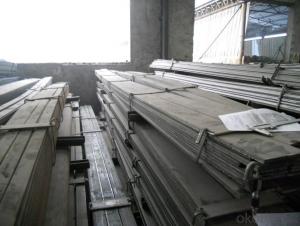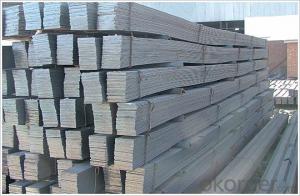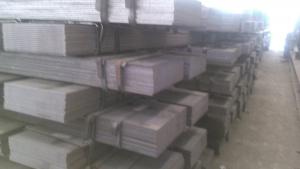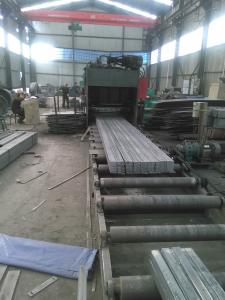Spring Steel Flat Bar with high quality
- Loading Port:
- Tianjin
- Payment Terms:
- TT or LC
- Min Order Qty:
- 25 m.t
- Supply Capability:
- 100 m.t/month
OKorder Service Pledge
OKorder Financial Service
You Might Also Like
Item specifice
Product Description:
OKorder is offering Spring Steel Flat Bar with high quality at great prices with worldwide shipping. Our supplier is a world-class manufacturer of steel, with our products utilized the world over. OKorder annually supplies products to European, North American and Asian markets. We provide quotations within 24 hours of receiving an inquiry and guarantee competitive prices.
Product Applications:
Spring Steel Flat Bar with high quality are ideal for structural applications and are widely used in the construction of buildings and bridges, and the manufacturing, petrochemical, and transportation industries.
Product Advantages:
OKorder's Spring Steel Flat Bar with high quality are durable, strong, and resist corrosion.
Main Product Features:
· Premium quality
· Prompt delivery & seaworthy packing (30 days after receiving deposit)
· Corrosion resistance
· Can be recycled and reused
· Mill test certification
· Professional Service
· Competitive pricing
Product Description:
Specification of Steel Flat Bar
Commodity: Mild Steel Flat Bar
Standard: GB;JIS
Material: Q195-235;SS400
Origin place: China
Thickness: 3mm-30mm
Width:20mm-200mm
Length: Max 12m
Certification: SGS/BV
Usage/Applications of Steel Flat Bar
Widely used for construction, Machinery manufacturing, Iron tower steel structure, Shipbuilding; Steel grating, Staircase, Bridge, Viaduct, Railway spare parts, Boilers making etc.
Packaging & Delivery of Mild Steel Flat Bar
Packaging Details: The Mild Steel Flat Bars are packed in bundles and loaded in 20 feet/40 feet container, or shipped by bulk cargo ,also we can do as customer's requirements.
Delivery Details:30~45 days upon the receipt of buyer payment by T.T. or L/C.
Production Flow of Steel Flat Bar
The Mild steel flat bar is made through three processes:
1.Feeding the material: Feeding the row material (the steel plate) to Slitting Line.
2.Slitting:The steel plate would be slitted into expected width by lengthways cutter.
3. Leveled and cutting: The plat bar would be ground into level by the grinder and then cut into required length
FAQ:
Q1: Why buy Materials & Equipment from OKorder.com?
A1: All products offered byOKorder.com are carefully selected from China's most reliable manufacturing enterprises. Through its ISO certifications, OKorder.com adheres to the highest standards and a commitment to supply chain safety and customer satisfaction.
Q2: How do we guarantee the quality of our products?
A2: We have established an advanced quality management system which conducts strict quality tests at every step, from raw materials to the final product. At the same time, we provide extensive follow-up service assurances as required.
Q3: How soon can we receive the product after purchase?
A3: Within three days of placing an order, we will begin production. The specific shipping date is dependent upon international and government factors, but is typically 7 to 10 workdays.
image:
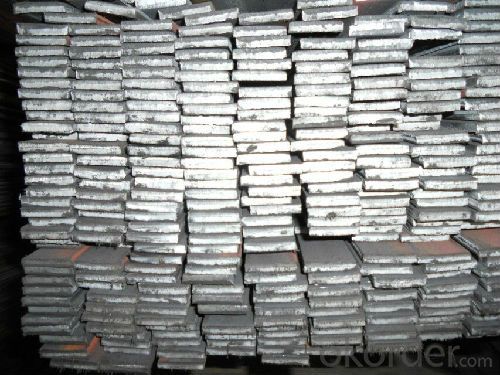
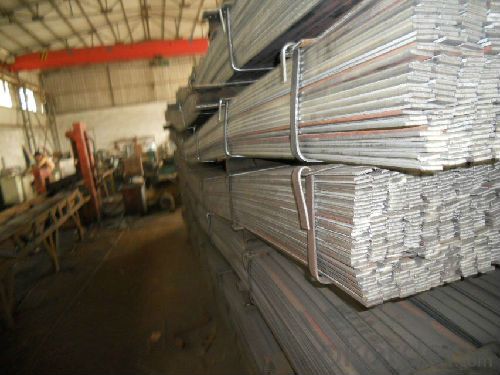
- Q:Can steel flat bars be bent or formed into different shapes?
- Yes, steel flat bars can be bent or formed into different shapes. Steel is a highly malleable material, which means it can be easily manipulated and shaped without breaking or cracking. Bending or forming steel flat bars can be achieved by using various methods such as heat bending, cold bending, or using specialized machinery like a press brake. The flexibility and versatility of steel make it a popular choice for construction, manufacturing, and various other industries where customized shapes and structures are required.
- Q:Can steel flat bars be used in the manufacturing of agricultural equipment?
- Indeed, the utilization of steel flat bars is possible in the production of agricultural equipment. Steel, being a robust and durable material, is highly suitable for the rigorous conditions and extensive utilization commonly encountered by agricultural machinery. Steel flat bars find application in numerous areas, including the construction of frames, supports, brackets, and other structural components within agricultural equipment. By offering stability, strength, and resistance against wear and tear, they prove to be an ideal choice for incorporation into the manufacturing process of agricultural machinery. Moreover, steel flat bars can be easily manipulated, welded, and tailored according to specific design requirements, thereby further enhancing their effectiveness within the realm of agricultural equipment production.
- Q:What are the different methods of surface patterning for steel flat bars?
- Steel flat bars can be patterned using various methods, each with its own unique benefits and characteristics. 1. Hot rolling involves passing the steel flat bar through heated rollers, creating a uniform surface pattern. Patterns such as diamond, tear, or checker plate can be produced through hot rolling, offering improved grip and aesthetic appeal. 2. Cold rolling is similar to hot rolling, but performed at room temperature. This results in a smoother and more refined surface pattern. Cold rolling is commonly used for patterns like smooth or brushed finishes. 3. Embossing utilizes high pressure to imprint intricate designs and textures onto the surface of the steel flat bar. It is ideal for decorative purposes, allowing for the creation of eye-catching patterns. 4. Sandblasting entails blasting fine particles of sand or other abrasives onto the steel flat bar's surface. This process creates a rough and textured finish, commonly used for enhanced grip or unique aesthetic appearance. 5. Acid etching involves applying an acid solution to the steel flat bar's surface, selectively removing the top layer of metal to create patterns or designs. Acid etching is often used for intricate and detailed patterns. 6. Laser cutting employs a high-powered laser beam to cut or engrave patterns onto the steel flat bar's surface. This method offers precise and accurate results, enabling the creation of complex designs and patterns. 7. Powder coating entails applying a dry powder onto the steel flat bar's surface, followed by heating to form a protective and decorative coating. It allows for the application of different colors and finishes, providing aesthetic appeal and corrosion resistance. In conclusion, the various methods of surface patterning for steel flat bars offer a wide range of options to enhance grip, improve aesthetics, and protect against corrosion. The choice of method depends on the desired pattern, functionality, and intended application of the steel flat bar.
- Q:How do steel flat bars compare to other materials like wood or plastic?
- Steel flat bars have several advantages over materials like wood or plastic. Firstly, steel is an incredibly strong and durable material. It has a high tensile strength, meaning it can withstand heavy loads and resist bending or breaking. This makes steel flat bars ideal for applications where strength and stability are crucial, such as in construction or industrial settings. In comparison, wood and plastic are not as strong and can easily warp, crack, or break under pressure. Additionally, steel is highly resistant to weathering and corrosion. Unlike wood, which can rot or be damaged by insects, or plastic, which can fade or become brittle over time, steel flat bars can withstand harsh environmental conditions. This makes them suitable for outdoor applications, such as in fencing or furniture, where exposure to moisture or sunlight is a concern. Moreover, steel flat bars offer excellent fire resistance. Unlike wood, which is highly flammable, or plastic, which can melt and release toxic fumes when exposed to heat, steel is non-combustible and does not contribute to the spread of fire. This makes steel flat bars a safer choice in areas where fire safety is a priority, such as in commercial buildings or infrastructure. Furthermore, steel is a versatile material that can be easily shaped, welded, or manipulated to suit different design requirements. This flexibility allows for a wide range of applications, from structural support in buildings to decorative elements in furniture. In comparison, wood and plastic may have limitations in terms of their formability or the complexity of shapes they can achieve. Finally, steel flat bars have a long lifespan with minimal maintenance requirements. Unlike wood, which needs regular staining or sealing, or plastic, which may require periodic cleaning or polishing, steel flat bars are relatively low-maintenance. They do not need to be treated or protected against pests or weathering, reducing the overall costs and efforts associated with their upkeep. In summary, steel flat bars offer superior strength, durability, weather resistance, fire resistance, versatility, and low maintenance compared to materials like wood or plastic. These qualities make steel flat bars an excellent choice for various applications, especially in demanding environments where reliability and longevity are essential.
- Q:Are steel flat bars available in different grades and alloys?
- Yes, steel flat bars are available in different grades and alloys. Steel is a versatile material that can be modified to suit specific applications by varying its composition. Different grades and alloys of steel have different properties, such as strength, corrosion resistance, and machinability. Some common grades and alloys of steel used for flat bars include carbon steel, stainless steel, and alloy steel. Carbon steel flat bars are typically used for structural applications, while stainless steel flat bars are chosen for their corrosion resistance and aesthetic appeal. Alloy steel flat bars are often used for their enhanced strength and durability. The choice of grade and alloy depends on the specific requirements of the application, and manufacturers typically offer a wide range of options to cater to different needs.
- Q:Do I need to make the ring galvanized flat steel ground connection between the electric well and the distribution room?
- There are two forms, one, as you say, because the distribution room has high voltage equipment and cables, and the total equipotential balance is uneven. Repeated earthing of the equipment is required.
- Q:How do you remove burrs or sharp edges from steel flat bars?
- There are several methods available for removing burrs or sharp edges from steel flat bars: 1. Grinding: Utilizing a grinding wheel or belt sander is a commonly used technique. Simply hold the steel flat bar firmly and glide it along the grinding wheel or belt sander, applying moderate pressure. Move the bar back and forth, ensuring all edges are evenly ground until the burrs or sharp edges are eliminated. 2. Deburring tools: Various handheld deburring tools specially designed for eliminating burrs and sharp edges from metal surfaces can be found on the market. These tools typically have a handle with a replaceable blade or cutting bit. Securely hold the steel flat bar and run the deburring tool along the edges to shave off the burrs. 3. File: Another effective tool for removing burrs from steel flat bars is a metal file. Choose a file with a fine or medium tooth pattern, depending on the severity of the burrs. Hold the file at an angle to the steel bar and apply even pressure while moving it back and forth along the edges. Continue filing until the burrs are smoothed out. 4. Sandpaper: If the burrs are not too severe, sandpaper can also be used. Begin with a coarse-grit sandpaper and gradually progress to finer grits until the burrs are no longer present. Wrap the sandpaper around a wooden block or use your hand to sand the edges evenly. Always remember to wear protective gloves and eyewear when working with metal to avoid injury. Additionally, it is crucial to securely fasten the steel flat bar before attempting any of the aforementioned methods to ensure stability and prevent accidents.
- Q:How do steel flat bars compare to other materials like concrete or glass?
- Steel flat bars have several advantages over other materials like concrete or glass. Firstly, steel flat bars are extremely strong and durable. They have a high tensile strength, which means they can withstand heavy loads and resist deformation. In comparison, concrete is strong in compression but weak in tension, whereas glass is brittle and prone to breaking. Steel flat bars are a much more reliable and long-lasting option when it comes to structural applications. Secondly, steel flat bars offer versatility in terms of design and construction. They can be easily fabricated into various shapes and sizes, making them suitable for a wide range of applications. Concrete, on the other hand, requires complex formwork and curing processes, while glass often has limitations in terms of size and shape. Steel flat bars provide greater flexibility in design and can be easily modified or adjusted if needed. Additionally, steel flat bars have excellent thermal conductivity, which makes them ideal for applications where heat transfer is important. Concrete and glass, on the other hand, have lower thermal conductivity and are not as efficient in transferring heat. This makes steel flat bars a preferred choice for applications such as heat exchangers or structural components in buildings where temperature control is crucial. Moreover, steel flat bars have a higher resistance to fire compared to concrete or glass. They can withstand high temperatures for a longer period without losing their structural integrity. Concrete tends to crack and spall under extreme heat, while glass can shatter or melt. Steel flat bars provide superior fire resistance, making them a safer choice in applications where fire protection is a concern. In conclusion, steel flat bars offer numerous advantages over materials like concrete or glass. They are stronger, more versatile, have better thermal conductivity, and higher resistance to fire. These qualities make steel flat bars a preferred choice for various applications, ranging from structural construction to industrial equipment.
- Q:How do steel flat bars perform under cyclic loading conditions?
- Steel flat bars perform well under cyclic loading conditions due to their high strength and ductility. They are able to withstand repeated loading and unloading without experiencing significant deformation or failure. Additionally, the homogeneous nature of steel ensures consistent performance throughout the cyclic loading process, making it a reliable choice for structural applications.
- Q:Are steel flat bars available in different profiles?
- Yes, steel flat bars are available in different profiles. The profiles refer to the shape or design of the flat bar. Some common profiles include square edge, round edge, and chamfered edge. Square edge flat bars have sharp corners and straight edges, making them suitable for various applications such as construction, manufacturing, and fabrication. Round edge flat bars have rounded corners and edges, which provide a smoother and safer finish, often used for architectural purposes or in industries where safety is a concern. Chamfered edge flat bars have beveled edges, allowing for a more aesthetically pleasing appearance and easy handling. These different profiles offer versatility and allow for customization based on specific project requirements.
1. Manufacturer Overview |
|
|---|---|
| Location | |
| Year Established | |
| Annual Output Value | |
| Main Markets | |
| Company Certifications | |
2. Manufacturer Certificates |
|
|---|---|
| a) Certification Name | |
| Range | |
| Reference | |
| Validity Period | |
3. Manufacturer Capability |
|
|---|---|
| a)Trade Capacity | |
| Nearest Port | |
| Export Percentage | |
| No.of Employees in Trade Department | |
| Language Spoken: | |
| b)Factory Information | |
| Factory Size: | |
| No. of Production Lines | |
| Contract Manufacturing | |
| Product Price Range | |
Send your message to us
Spring Steel Flat Bar with high quality
- Loading Port:
- Tianjin
- Payment Terms:
- TT or LC
- Min Order Qty:
- 25 m.t
- Supply Capability:
- 100 m.t/month
OKorder Service Pledge
OKorder Financial Service
Similar products
New products
Hot products
Hot Searches
Related keywords
